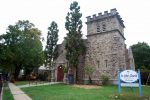P’ville’s St. John’s Episcopal Recommended for Historic Registry
By Andrew Vitelli

St. John’s Episcopal Church in Pleasantville has long been known to local historians for its stunning architecture and fascinating history. Now, the church is gaining national recognition, as it has been recommended by Gov. Andrew Cuomo for inclusion in the State and National Registers of Historic Places.
“The church, erected in 1912, is an outstanding expression of early twentieth century Gothic Revival-style ecclesiastical architecture, and one which is further complemented by the adjacent 1929 parish house,” William Krattinger, a Historic Preservation program analyst for New York State, wrote in an April letter. “The church complex, inclusive of the rectory, appears to clearly satisfy the criteria for listing on the registers.”
The church, located at 8 Sunnyside Ave. at the corner of Bedford Road, was designed by architect Charles Hoag, and its Gothic Revival design played a large role in its historic status. But what’s taken place within the building’s walls is equally impressive; in 1928, a nephew of the King of Sweden held his nuptials at the church, the first time European royalty was married in the United States.
“There’s a sense of pride that we’ve been entrusted with the care of this building, this place of God in this little corner in the world, by people who had the foresight to build it 100 years ago,” said Rev. Mary Gregorius, the church’s rector. “Taking care of it is a responsibility and a joy.”
St. John’s was first established in 1853 as a mission church of Grace Church in White Plains, in the building that is now the Pleasantville Community Synagogue on Bedford Road. The rectory, included in the historic designation, dates to 1734, making it the second oldest building in Pleasantville.
Matt Ruvo, a member of St. John’s vestry who worked on the church’s application for the registers, said the rectory was included in the application after an analyst noticed the historic building during a site visit.
Ruvo said the application was extensive and took about six months to complete. It was submitted at the New York State Board for Historic Preservation’s Sept. 22 meeting.
“It was very interesting to dig up all this history,” Ruvo noted. “From a perspective of the community of Pleasantville, I think it’s a crown in Pleasantville’s cap.”
Gregorius said that most of the church’s parishioners are already aware of St. John’s storied past.
“I think people have a sense of pride about it, that that’s my little church,” she explained. “It’s kind of like finding out you had a relative that fought in the Revolutionary War.”
She is excited that the designation will raise further awareness and that it may also generate funding to complete needed restoration work on the buildings and to make them more energy efficient. The village, meanwhile, has long showcased the church to highlight Pleasantville’s history. A photo of St. John’s is one of several rotating pictures on the front page of the village’s website.
“St. John’s Episcopal Church has been a treasured landmark in Pleasantville since the turn of the 20th century,” Pleasantville Mayor Peter Scherer said in a press release. “I am delighted at the prospect that our district could be honored with these important designations.”

Examiner Media – Keeping you informed with professionally-reported local news, features, and sports coverage.
